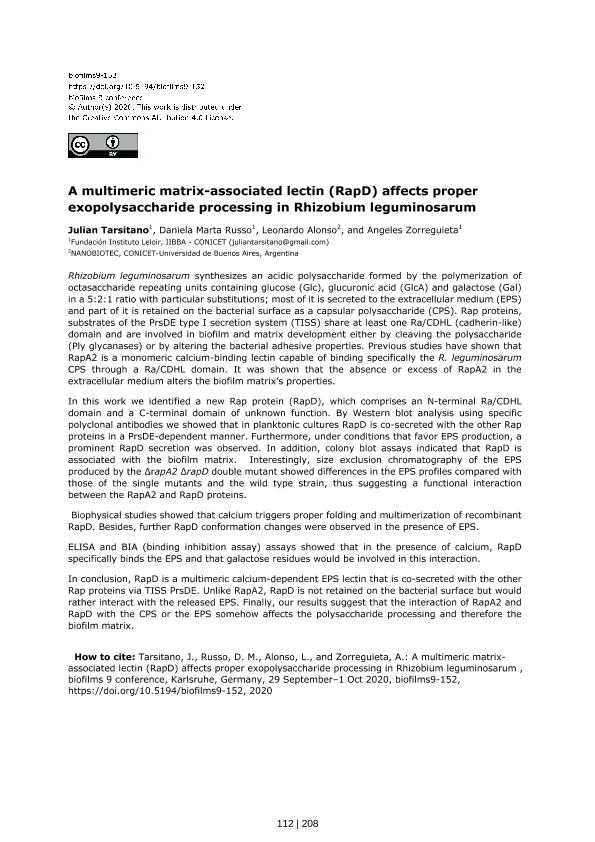Mostrar el registro sencillo del ítem
dc.contributor.author
Tarsitano, Julián

dc.contributor.author
Russo, Daniela Marta

dc.contributor.author
Alonso, Leonardo Gabriel

dc.contributor.author
Zorreguieta, Ángeles

dc.date.available
2022-03-21T14:09:56Z
dc.date.issued
2020
dc.identifier.citation
A multimeric matrix-associated lectin (RapD) affects proper exopolysaccharide processing in Rhizobium leguminosarum; Proceedings of the Biofilms 9 online conference; Karslruhe; Alemania; 2020; 112-112
dc.identifier.uri
http://hdl.handle.net/11336/153630
dc.description.abstract
Rhizobium leguminosarum synthesizes an acidic polysaccharide formed by the polymerization of octasaccharide repeating units containing glucose (Glc), glucuronic acid (GlcA) and galactose (Gal) in a 5:2:1 ratio with particular substitutions; most of it is secreted to the extracellular medium (EPS) and part of it is retained on the bacterial surface as a capsular polysaccharide (CPS). Rap proteins, substrates of the PrsDE type I secretion system (TISS) share at least one Ra/CDHL (cadherin-like) domain and are involved in biofilm and matrix development either by cleaving the polysaccharide (Ply glycanases) or by altering the bacterial adhesive properties. Previous studies have shown that RapA2 is a monomeric calcium-binding lectin capable of binding specifically the R. leguminosarum CPS through a Ra/CDHL domain. It was shown that the absence or excess of RapA2 in the extracellular medium alters the biofilm matrix's properties. In this work we identified a new Rap protein (RapD), which comprises an N-terminal Ra/CDHL domain and a C-terminal domain of unknown function. By Western blot analysis using specific polyclonal antibodies we showed that in planktonic cultures RapD is co-secreted with the other Rap proteins in a PrsDE-dependent manner. Furthermore, under conditions that favor EPS production, a prominent RapD secretion was observed. In addition, colony blot assays indicated that RapD is associated with the biofilm matrix. Interestingly, size exclusion chromatography of the EPS produced by the ΔrapA2 ΔrapD double mutant showed differences in the EPS profiles compared with those of the single mutants and the wild type strain, thus suggesting a functional interaction between the RapA2 and RapD proteins.Biophysical studies showed that calcium triggers proper folding and multimerization of recombinant RapD. Besides, further RapD conformation changes were observed in the presence of EPS. ELISA and BIA (binding inhibition assay) assays showed that in the presence of calcium, RapD specifically binds the EPS and that galactose residues would be involved in this interaction. In conclusion, RapD is a multimeric calcium-dependent EPS lectin that is co-secreted with the other Rap proteins via TISS PrsDE. Unlike RapA2, RapD is not retained on the bacterial surface but would rather interact with the released EPS. Finally, our results suggest that the interaction of RapA2 and RapD with the CPS or the EPS somehow affects the polysaccharide processing and therefore the biofilm matrix.
dc.format
application/pdf
dc.language.iso
eng
dc.publisher
Biofilms
dc.rights
info:eu-repo/semantics/openAccess
dc.rights.uri
https://creativecommons.org/licenses/by/2.5/ar/
dc.subject
MATRIX
dc.subject
RAPD
dc.subject
LECTIN
dc.subject
EXOPOLYSACCHARIDE
dc.subject
RHIZOBIUM
dc.subject.classification
Biología Celular, Microbiología

dc.subject.classification
Ciencias Biológicas

dc.subject.classification
CIENCIAS NATURALES Y EXACTAS

dc.title
A multimeric matrix-associated lectin (RapD) affects proper exopolysaccharide processing in Rhizobium leguminosarum
dc.type
info:eu-repo/semantics/publishedVersion
dc.type
info:eu-repo/semantics/conferenceObject
dc.type
info:ar-repo/semantics/documento de conferencia
dc.date.updated
2022-02-04T13:31:26Z
dc.journal.pagination
112-112
dc.journal.pais
Alemania

dc.journal.ciudad
Karlsruhe
dc.description.fil
Fil: Tarsitano, Julián. Consejo Nacional de Investigaciones Científicas y Técnicas. Oficina de Coordinación Administrativa Parque Centenario. Instituto de Investigaciones Bioquímicas de Buenos Aires. Fundación Instituto Leloir. Instituto de Investigaciones Bioquímicas de Buenos Aires; Argentina
dc.description.fil
Fil: Russo, Daniela Marta. Consejo Nacional de Investigaciones Científicas y Técnicas. Oficina de Coordinación Administrativa Parque Centenario. Instituto de Investigaciones Bioquímicas de Buenos Aires. Fundación Instituto Leloir. Instituto de Investigaciones Bioquímicas de Buenos Aires; Argentina
dc.description.fil
Fil: Alonso, Leonardo Gabriel. Consejo Nacional de Investigaciones Científicas y Técnicas. Oficina de Coordinación Administrativa Houssay. Instituto de Nanobiotecnología. Universidad de Buenos Aires. Facultad de Farmacia y Bioquímica. Instituto de Nanobiotecnología; Argentina
dc.description.fil
Fil: Zorreguieta, Ángeles. Consejo Nacional de Investigaciones Científicas y Técnicas. Oficina de Coordinación Administrativa Parque Centenario. Instituto de Investigaciones Bioquímicas de Buenos Aires. Fundación Instituto Leloir. Instituto de Investigaciones Bioquímicas de Buenos Aires; Argentina
dc.relation.alternativeid
info:eu-repo/semantics/altIdentifier/url/https://www.biofilms9.kit.edu
dc.relation.alternativeid
info:eu-repo/semantics/altIdentifier/url/https://meetings.copernicus.org/biofilms9/biofilms-9-proceedings.pdf
dc.relation.alternativeid
info:eu-repo/semantics/altIdentifier/url/https://meetingorganizer.copernicus.org/biofilms9/biofilms9-152.html
dc.conicet.rol
Autor

dc.conicet.rol
Autor

dc.conicet.rol
Autor

dc.conicet.rol
Autor

dc.coverage
Internacional
dc.type.subtype
Conferencia
dc.description.nombreEvento
Proceedings of the Biofilms 9 online conference
dc.date.evento
2020-09-29
dc.description.ciudadEvento
Karslruhe
dc.description.paisEvento
Alemania

dc.type.publicacion
Journal
dc.description.institucionOrganizadora
Karlsruhe Institute of Technology
dc.source.revista
Proceedings of the Biofilms 9 online conference
dc.date.eventoHasta
2020-10-01
dc.type
Conferencia
Archivos asociados
